10 minutes07/03/2019
Written by Timo Kronlöf
What’s the first thing you think of when you hear EHSQ software? Based on your past experiences, it could be positive or negative. From what I’ve seen during my career in the EHSQ software business, EHSQ software has a rather negative or at best neutral public perception. Why is it like this, and how can you avoid these feelings of frustration and disappointment in the future? Please allow me to share some valuable lessons from the most common mistakes I’ve seen along the way.
1. Trying to copy-paste your current processes directly
The first examples of EHSQ software were basically identical to their paper-based counterparts. Can you imagine? Digitizing a paper form, such as a near-miss report, meant crafting the very same form to be available on PC. For me, filling out this kind of digital form is usually even more annoying than just using paper and pen—at least you don’t need to log in or boot up your laptop!
Even if it was rather amusing to see the first EHSQ tools, it really isn’t funny at all to see people still using them today. The frustration is painful to watch. Nowadays, I understand pretty well why people aren’t inspired by any EHSQ solutions.
Today’s EHSQ solutions are—or at least should be—very different from those first efforts. Technology has advanced, and the EHSQ solutions should have too. Try to avoid making the same mistake again: when choosing software, use the opportunity to re-think your processes. While it’s tempting to try to replicate existing working processes, at least ask your potential solution provider for ideas on how to improve the whole process.
2. Failure to involve relevant stakeholders from the beginning
We all know that decision making gets more complex the more people are involved. Nevertheless, it is crucial to get additional opinions. Even if you are sure you are choosing the best EHSQ software for your organization, it still doesn’t mean everyone will be satisfied and happy when you start implementation.
When you plan to start the EHSQ software project, it’s important to consult at least these 5 key stakeholder groups: 1. top management/C-suite, 2. operations, 3. EHSQ team, 4. workers’ representatives, 5. IT. Asking for a list of their pain-points and addressing their concerns will help you dramatically along the way. Involving stakeholders early has also the advantage that it creates a feeling of participation which later on lowers the resistance to change when implementing.
3. Not identifying the most relevant processes to digitize at first
Many think, somewhat idealistically, that need to—and are able to—solve all things at once. It doesn’t matter if you are leading a multinational corporation or an SME, you still need to pick the most important processes to start with. This depends on your organization. It could be incident management, risk management, auditing and inspections, or controlling your hazardous chemicals better. Or it might be more about engaging your people better—creating an EHSQ culture. Very often, I’ve seen that in the end, the main challenge wasn’t about digitizing specific processes, but about getting more people involved, improving communication, and becoming more productive in the EHSQ space.
Ask yourself what YOU would change about your EHSQ management today. Then ask your leaders, colleagues, and other stakeholders the same question. They will probably be happy to share their thoughts on the subject. Remember, don’t blame anyone—not even yourself. Decisions that have been made in the past are made with different information than what you possess today.
4. Outsourcing final decision making—don't risk losing EHSQ’s relevance
Next, some extremely critical advice: Don’t let other organizational functions determine or decide for you. If you want professional EHSQ software, don’t let maintenance, finance, IT, or anyone else with limited understanding and scope decide for you. If you are looking for more a comprehensive EHSQ platform, please involve other stakeholders, but keep the final decision in your hands. Allowing the final decision to be made by other stakeholders is one of the biggest mistakes you can make in EHSQ. This will take you out of all critical decisions in the future when developing your EHSQ management, and ultimately, the culture thereof. Don’t get me wrong, I love IT to be involved but they look things from a completely different angle. How could IT or maintenance know, or sometimes even care, about the future development of EHSQ and safety management? What if you’d like to pilot a new ‘safety II’ methodology, do you think others would agree to add or prioritise this new feature to a maintenance solution? How about expanding the chosen solution to hazardous chemicals or legal compliance in EHSQ? Yes, I know you are busy, but it’s important to understand that this decision could easily end up being the most critical in your career path within your current organization. This decision of software scope determines who is the driver and who’s just a passenger.
5. Postpone and waste time comparing the smallest details
Companies and organizations are not the same, nor are their processes or their EHSQ cultures. So why should all software be the same, and how could a construction or maintenance app with some safety features be the best choice for you if you’re working in a service business? Try to find the best fit for your business and working environment. Core EHSQ management processes are rather universal but working environments are not.
Try asking yourself these questions:
How many of our people (%) are working in the field—without direct access to PC?
What’s the split between white- and blue-collar workers?
What distinctive and critical EHSQ processes do we have based on our industry, work styles, or culture?
Is your focus on one site unit, physical location or area, or rather more complex and global? What are the differences between locations, countries and which processes would you like to harmonize across all locations and business units?
Ask and verify that the potential solution can address these critical issues. Ask which references they have in your industry, to proof that. Verify your decision by asking for reference calls or visits. Ask the references how the collaboration has been working, if the solution has been updated as promised, and whether their promises have been kept. Buying an EHSQ software today is not just a one-time transaction, but ideally a long-term partnership between two organizations, one that sees both organizations gain value as time passes. Evaluate the risk of only comparing initial price tag of potential solutions and rather consider your investment over a longer period of time. If the solution provider isn’t able to invest in development of their product and service, their approach might deteriorate the long-term value created.
After you have evaluated the potential solution or solutions, verified the claims from the sales pitches and material, called the references, and done your due diligence, it’s time to move forward. Unnecessary time spent in this stage will disrupt the flow and drive you’ve worked hard to create—and risk making your efforts obsolete.
Regardless of the wide-ranging topics that I just made you wonder, successful EHSQ software projects can be straight-forward and enjoyable. If you’ve done your homework and chosen the best-suited software partner, you should be in good hands. Let them help you with best practices, and to support your implementation project. They’ve probably done it multiple times and for sure have some great insights, networks and professionals to help you avoid the most typical pitfalls along the way.



